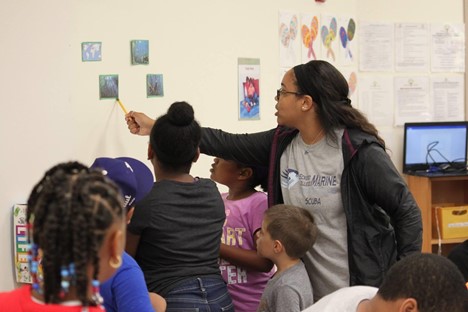The Challenges of Creating a Culturally Relevant and Age-Appropriate Ocean Science Summer Camp Curriculum
 Over the last several weeks, as I have begun the process of creating the ocean science summer camp curriculum, I have learned an enormous amount about the curriculum design process. This is my first time designing such a large (i.e., 9-week) curriculum, and I quickly learned that my previous way of creating curriculum was not time efficient or organized enough to tackle this new project. Thus, I spent the first few weeks of my project contacting faculty in the education department at local colleges and universities to learn more about their curriculum design process. From these conversations, I learned a lot about how to properly design a curriculum and received numerous resources to assist me throughout this process. I recently finished outlining the goals and objectives of the curriculum and identifying the focus of each of the 9-weeks, as well as all the major concepts I want to cover during each of those weeks. I am currently working on designing the activity and lesson plans for weeks 1-3, which I hope to complete soon.
Over the last several weeks, as I have begun the process of creating the ocean science summer camp curriculum, I have learned an enormous amount about the curriculum design process. This is my first time designing such a large (i.e., 9-week) curriculum, and I quickly learned that my previous way of creating curriculum was not time efficient or organized enough to tackle this new project. Thus, I spent the first few weeks of my project contacting faculty in the education department at local colleges and universities to learn more about their curriculum design process. From these conversations, I learned a lot about how to properly design a curriculum and received numerous resources to assist me throughout this process. I recently finished outlining the goals and objectives of the curriculum and identifying the focus of each of the 9-weeks, as well as all the major concepts I want to cover during each of those weeks. I am currently working on designing the activity and lesson plans for weeks 1-3, which I hope to complete soon.
One of my big goals in designing this curriculum is to make ocean science culturally relevant for inner city students of color. Additionally, I wanted the curriculum to be interactive and engaging with a lot of hands-on activities. This proved to be more challenging than I originally thought, and to accomplish this I had to make connections between marine ecosystems and terrestrial and aquatic systems, which are environments most camp students would have access to on a daily basis. Furthermore, in designing the curriculum, I had to do so with various age groups in mind.
Since the camp is for students in grades K-6, it was important to design activities that students can do regardless of age, as the abilities of students in kindergarten are vastly different than those of students in 6th grade. Thus, our activities had to be designed in a way that camp instructors could easily simplify them for younger students and make them more challenging for older students.
This process has also challenged me creatively by making me think critically about how to present ocean concepts in a culturally relevant way. This not only includes how I present scientific concepts, but also the scientists behind the science. With geosciences being one of the least racially diverse fields, and this curriculum being designed primarily for students of color, it is imperative that students feel a sense of belonging within the field of ocean science. This means that it would be counterproductive to constantly display images of scientists that students cannot identify with. Thankfully, due to recent events within the scientific community, such as “Black in Marine Science” week, it has become easier to find images and videos of marine scientists of color. I have been able to utilize information from the Black in Marine Science website and YouTube channel in my lesson plans and activities for the ocean science curriculum.
Although the process of designing the ocean science curriculum proved to be more challenging and time-intensive than I previously thought, I have been learning an enormous amount about the curriculum design process, information that will assist me in designing curriculum for various age-groups throughout my career.
